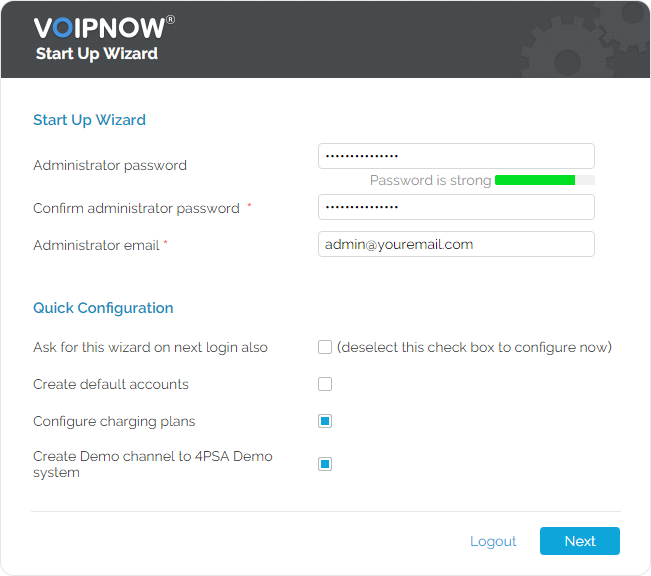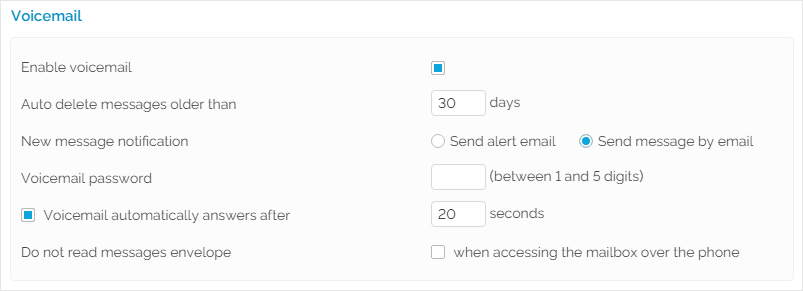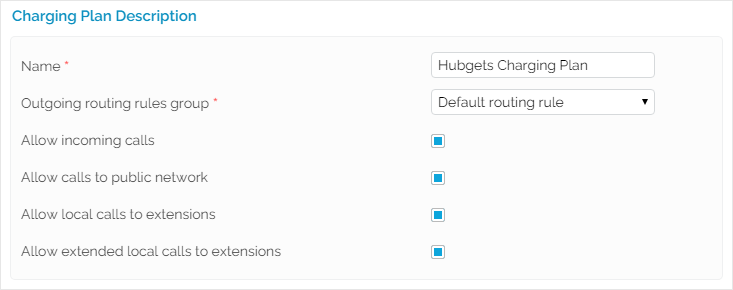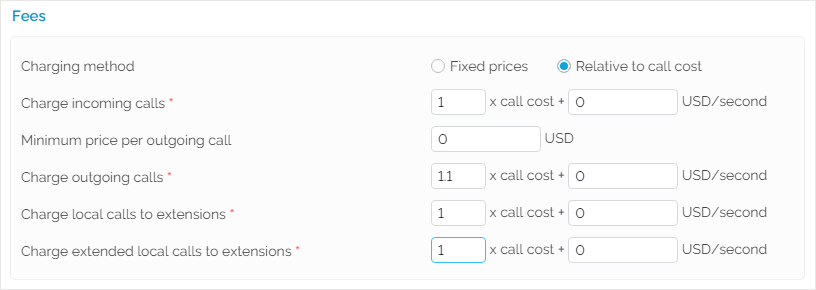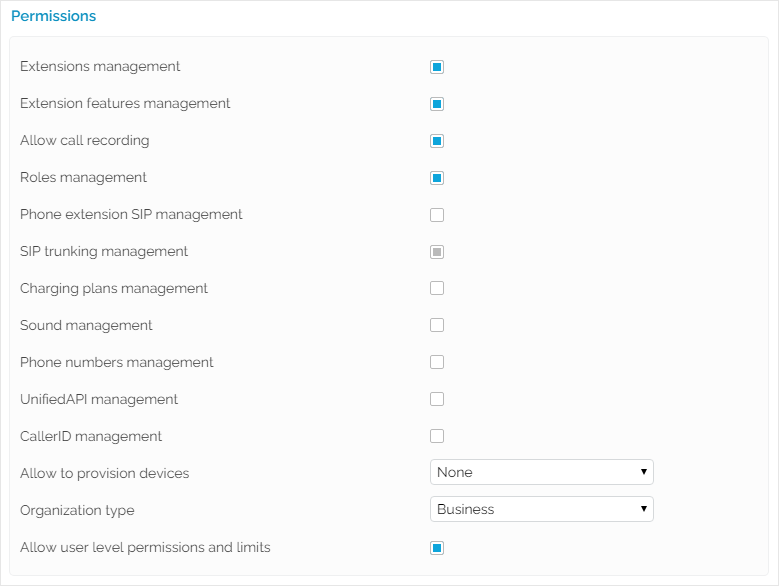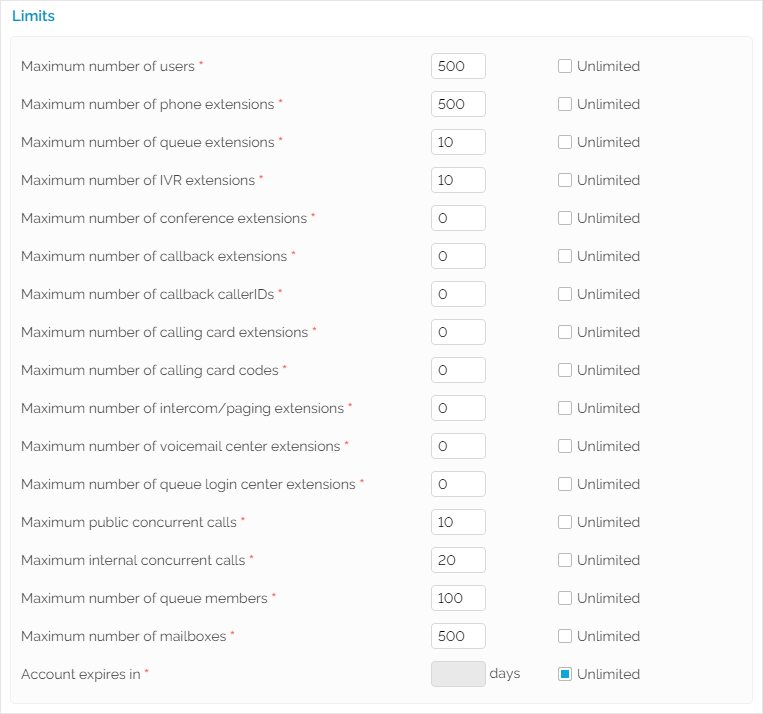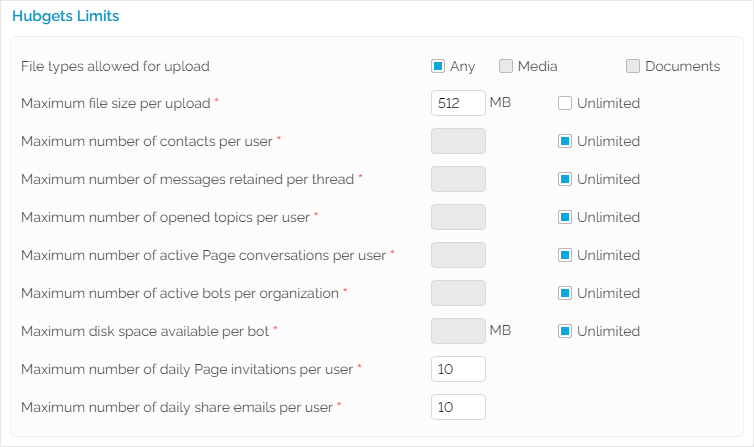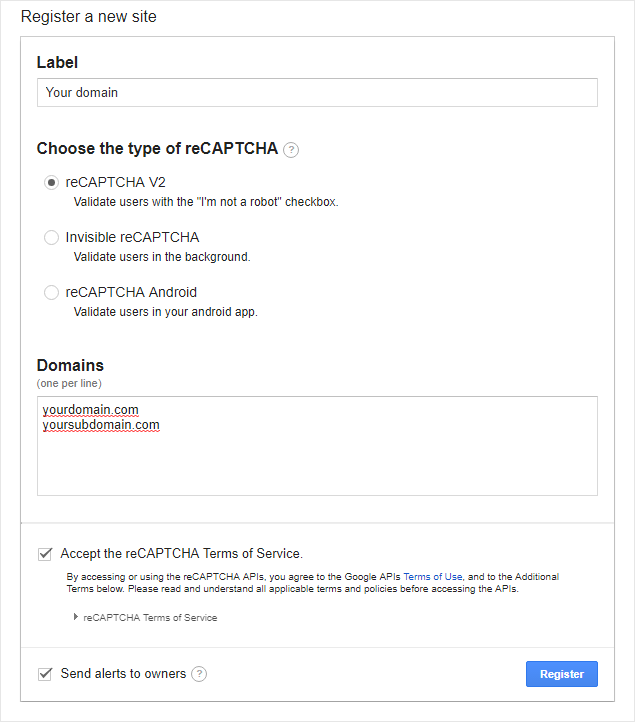VoipNow 5.X.X is shipped out-of-the-box with Hubgets, so that you can deliver full communication and collaboration services to your customers.
This guide is a walkthrough the operations you need to perform in VoipNow so that your customers can use Hubgets services. Assuming you have already installed or upgraded to VoipNow 5.X.X, here are the steps to take to enable Hubgets services and create your first Hubgets organization and user.
| Table of Contents | ||
|---|---|---|
|
Requirements
- Virtual machine or hardware compliant with VoipNow requirements
- Hostname
- Certificate for the hostname or wildcard for the domain signed by a public CA
| Note |
|---|
This guide contains the steps to take for enabling Hubgets services and creating your first Hubgets organization and user. However, the values of the settings explained here are just for exemplification and testing purposes only. |
#1 Install the SSL certificate
The certificate must be installed in /etc/voipnow/certs directory.
If you need help with the certificate installation process, follow the instructions in this article .
| Note |
|---|
Please keep in mind that you need to update at least the certificates for Kamailio and HTTP. |
#2 Change your default admin password
For security reasons, it's best to change your default password if you haven't done it until now.
To do this, run the following command:
| Code Block |
|---|
/usr/local/voipnow/bin/chadminpass.sh |
#3 Follow the wizard instructions
- Log in the VoipNow interface using your username and recently changed password. You will be redirected to the Terms of Service page.
- Make sure to agree with the Master Service Agreement. Otherwise you won't be able to continue the Wizard tour.
- You will be prompted to the VoipNow Start Up Wizard page.
- If you haven't changed your admin password in STEP #2, you can do it in the Start Up Wizard page. If you already changed your admin password, this section will no longer be displayed.
- In the Quick Configuration section, the Ask for this wizard on next login also is enabled by default. Make sure to deselect it so that you can start the configuration process.
- Select the Configure charging plans and Create Demo channel to 4PSA Demo system options. To make the configuration process easier for you, we have already created a default charging plan and a demo channel that will allow you to test Hubgets.
- Press Next to continue the configuration process.
| Note |
|---|
If you don't want to use the default charging plan and DEMO channel, you can easily create them by yourself later. However, for the evaluation period, we recommend that you use these default settings. |
#4 Enter your admin contact details
Fill in the required fields of the Admin Contact Information page and pay special attention to the email address for your admin account. This address cannot be the same as the one you're going to use for your account.
| Note |
|---|
You cannot use the same e-mail address for your admin and user accounts! |
#5 Set your codecs right
Go to System → Unified Communications → Zero Priority → General and make the following changes:
- Under Extension Settings, select the following mandatory codecs: G.711 A-Law, G.711 u-Law, all Opus codecs, H.264, VP8 and VP9.
- Scroll down to the Message Notifications section and enter an email address in the Server sends emails from address field. VoipNow will use this email address when sending system notifications to users.
- Go to the In the 'From email' field appears field and write "Hubgets" instead of the default "4PSA VoipNow".
- Press OK when you're done.
#6 Set your SIP preferences
Go to System → Unified Communications → Zero Priority → SIP and make the following changes:
- Under Global SIP Preferences, you need to set the Extension number length to 4 (to avoid overlapping emergency numbers like 911, 112, etc.) and set the User agent as Hubgets.
- Scroll down to Advanced SIP Server Preferences, fill in your domain and port in the Accept SIP requests to domain:port field.
- Press OK when you're done.
#7 Create an Extension template
In order to be able to invite users on Hubgets, you need to create a Subscription template. Your Subscription will use a specific Extension template and a customized charging plan.
| Note |
|---|
You cannot create a Subscription template without having an Extension template and a Charging plan in your VoipNow system. |
To create an Extension template, go to System → Unified Communications → Account Templates → Extension Templates and fill in the fields as shown below.
- Name your template Hubgets Webphone and enable the Shared with provider option.
- In the Extension Type Selection section, select Phone terminal as the Extension type.
- Leave the Basic Settings section as is. The default values are those that we recommend. You can change these settings for specific extensions at any time later on.
- In the Calling Features section, select the Call waiting active option.
- In the Voicemail section, select the Voicemail enabled option and customize the rest of the settings as shown below. Remember this is a template, so do not set a voicemail password.
- Make sure the Enable fax center option under the Fax Center section is disabled.
Go to the Call Recording section, select the Call recording function enabled option and then set the Record triggered option to When *1 is pressed. Do not fill in the Auto delete recordings older than [...] days field.
Note Please note that if you do not enable the Call Recording feature in VoipNow, you won't be able to use this functionality in Hubgets.
- Press OK when you're done.
Your Hubgets Webphone template will be added to the system and you will find it in the Extension Templates table.
#8 Customize your charging plan
Since in the Wizard tour you opted for a default charging plan, you will find it already added to the system.
Go to System → Charging Plans and click on the Default service provider charging plan in the Charging Plans table. Name your plan Hubgets Charging Plan and customize settings using the examples shown below.
| Note |
|---|
If you already have other charging plans, you can equally use them. The charging plan settings below are for exemplification purposes only. |
- Set the Outgoing routing rules group to Default routing rule and enable the following types of calls: incoming calls, calls to public network, local calls to extensions and extended local calls to extensions.
- Set your Charging plan type to Postpaid and customize call limits as shown below.
- Leave the Charging Segments section as is.
- Under the Fees section, set the Charging method to Relative to call cost and set the fees as shown below.
- Press OK when you're done.
Your Hubgets Charging Plan will be added to the system and you'll find it in the Charging Plans table.
#9 Create a Subscription template
Now that you have created an Extension template and you have a customized charging plan in place, you can create a Subscription template.
For this purpose, go to System → Account Templates → Organization Templates → Add Template and fill in the fields as shown below.
- Name your template Hubgets Organization and select Subscription from the Type drop-down list. The Legacy template option does not give users access to Hubgets services.
- Make sure the settings under Permissions are similar to the ones shown below.
Under the Limits section, leave the Account expires in option set to Unlimited and customize the rest of the limits as shown below.
Note Remember these are just examples that are meant to help you test Hubgets.
- After setting the Computation algorithm under Storage Quota to be Based on active users, enter 1024MB in the Quota per user and select the Record quota on user level option.
- Up next, you need to set your Subscription template to use the extension template and the charging plan you previously created. From the Charging Plan drop-down list, select Hubgets Charging Plan. Also, from the Phone Extension Template drop-down list, select Hubgets Webphone.
- Set the Hubgets users allowed to access VoipNow option to Member and move on to the Hubgets Limits section.
- Leave the File types allowed for upload to Any and set the Maximum file size per upload to 512MB. The rest of the settings can be customized as shown below.
- Press OK when you're done.
Your Subscription template will be added to the system and you will find it in the Organization Templates table. When you create your Hubgets Organization, the system will use this subscription template.
#10 Create a Service Provider account
| Note |
|---|
If in the Wizard tour you didn't opt for a default charging plan, you need to add a charging plan to the system before creating this Service Provider account. |
To create a Service Provider account, select Service Providers from the main menu, click on Add Service Provider, and follow the instructions below:
- Fill in all required fields.
- Move on to the Charging and Outgoing Call Filtering section and select Hubgets Charging Plan from the Charging plan drop-down list.
- Enable the Choose service provider roles and phone numbers option and press OK. You will be redirected to the Roles and Phone Numbers page.
- Enable all Permissions and set all Limits with Unlimited value.
- Press OK when you're done. Your newly created Service Provider account will be added to the system and you will find it in the Service Providers table.
At this point, you need to define a couple of settings for the Email Templates of the Service Provider account:
- Select the account from the Service Providers table.
- In the provider's Management Tools page, go to Templates → Email Templates.
- In case you want to sell Hubgets accounts only, you need to go to the Email Templates Management page and disable all email templates for Organizations and Users. This will prevent your customers from receiving notification emails from VoipNow. Otherwise, leave these settings as they are.
- Press OK when you're done. The Service Provider's email templates will be updated with your latest changes.
#11 Create an Organization account based on subscription
To create an Organization, select the Service Provider account you've just created. You will be redirected to the provider's Management Tools page. Click on Add Organization and follow the instructions below:
- From the Creating using template drop-down list, select the Hubgets Organization template (i.e. the Subscription template) that you've created in STEP #9.
- Fill in the required fields.
- The Charging plan field under the Charging and Outgoing Call Filtering section is disabled since the Hubgets Charging Plan you already created in STEP #8 is automatically assigned to the Subscription template based on which your new Organization will be created.
- Press OK when you're done. You will be redirected to the Roles and Phone Numbers page of your newly created Organization.
- Press OK again without making any changes.
Your Organization will be added to the system and you will find it in the Organizations table.
#12 Create a User account
To create a User account, select the Organization you've just created from the Organizations table. You will be redirected to the Organization's Management Tools page. Click on Add User and follow the instructions below:
- Fill in the required fields paying special attention to the username, user password, email address and role.
- Set a password for the user to log in the Hubgets interface.
From the Role drop-down list, select Owner.
Note I t's important for the first user to have an Owner role because it will allow him/her to assign other users with member and administrator roles, change control panel access for any user (except for himself/herself), enable or disable users with any role (except for himself/herself), delete users with any role (except for himself/herself).
- Make sure to select the Choose phone numbers, create associated extension option and press OK.
- You will be redirected to the User's Roles and Phone Numbers page. Scroll down to the Create associate extension section, and from the Type drop-down list, select Phone terminal. From the Template drop-down list, select the Hubgets Webphone template. Enter webphone in the Label field and press OK.
At this point, you've created your first User account under your Hubgets Organization.
#13 Configure customer connectivity settings
To do this, go to System → Cloud Management and follow the instructions below.
| Note |
|---|
Without the configuration of these Cloud Management settings, you will not be able to test Hubgets. So, make sure you don't skip this step! |
- In the Node Listing table, there's a Role column. Click on SIP and you will be prompted the Assign Role form.
- Scroll down to the Customer Connectivity section, enter your hostname in the Public WebRTC IP/Hostname field and press OK.
- Go back to the Node Listing table and click on Web Management Interface in the Role column.
- Scroll down to the Customer Connectivity section, enter your hostname in the Public IP/Hostname field and press OK.
#14 Set Google reCAPTCHA
Google reCAPTCHA is a free service that VoipNow and Hubgets use to prevent spam and other types of automated abuse. The Google reCaptcha is also required for the Page by Hubgets feature to be functional.
To enable this service, you need to sign up with Google reCAPTCHA for an API key pair. If you don't know how to do that, follow the steps in this tutorial. The key pair consists in a site key and a secret key. The site key is used to invoke reCaptcha service on your web application. The secret key authorizes communication between your application back-end and the reCAPTCHA server to verify the user's response.
To set Google reCAPTCHA in VoipNow, take the following steps:
- Generate reCAPTCHA site key and secret key from here . Generate the keys for both your domain and subdomain.
- Copy the keys and go to System → Unified Communications→ Zero Priority→ Integration → Google reCAPTCHA.
- Paste the keys in the Site key and Secret fields and press OK.
#15 Edit the local configuration file
Edit /etc/voipnow/local.conf and ensure you have the values as shown below:
| Code Block |
|---|
SIP_NOTIFICATIONS 1 KAM_WORKERS 15 HTTP_SERVER_NAME [yourhostname] |
#16 Restart services
All the changes you've made will only take place if you restart services using the commands below:
| Code Block |
|---|
service kamailio restart service php-fpm restart service httpsa restart |
At this point, the user under your Hubgets Organization will be able to log in and use Hubgets.
Except where otherwise noted, content in this space is licensed under a Creative Commons Attribution 4.0 International.
